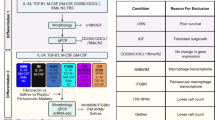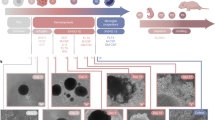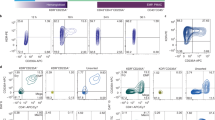Abstract
Microglia, the only lifelong resident immune cells of the central nervous system (CNS), are highly specialized macrophages that have been recognized to have a crucial role in neurodegenerative diseases such as Alzheimer's, Parkinson's and adrenoleukodystrophy (ALD). However, in contrast to other cell types of the human CNS, bona fide microglia have not yet been derived from cultured human pluripotent stem cells. Here we establish a robust and efficient protocol for the rapid production of microglia-like cells from human (h) embryonic stem (ES) and induced pluripotent stem (iPS) cells that uses defined serum-free culture conditions. These in vitro pluripotent stem cell–derived microglia-like cells (termed pMGLs) faithfully recapitulate the expected ontogeny and characteristics of their in vivo counterparts, and they resemble primary fetal human and mouse microglia. We generated these cells from multiple disease-specific cell lines and find that pMGLs derived from an hES model of Rett syndrome are smaller than their isogenic controls. We further describe a platform to study the integration and live behavior of pMGLs in organotypic 3D cultures. This modular differentiation system allows for the study of microglia in highly defined conditions as they mature in response to developmentally relevant cues, and it provides a framework in which to study the long-term interactions of microglia residing in a tissue-like environment.
This is a preview of subscription content, access via your institution
Access options
Subscribe to this journal
Receive 12 print issues and online access
$209.00 per year
only $17.42 per issue
Buy this article
- Purchase on Springer Link
- Instant access to full article PDF
Prices may be subject to local taxes which are calculated during checkout






Similar content being viewed by others
References
Tremblay, M.E. et al. The role of microglia in the healthy brain. J. Neurosci. 31, 16064–16069 (2011).
Alliot, F., Godin, I. & Pessac, B. Microglia derive from progenitors, originating from the yolk sac, and which proliferate in the brain. Brain Res. Dev. Brain Res. 117, 145–152 (1999).
Vitry, S., Bertrand, J.Y., Cumano, A. & Dubois-Dalcq, M. Primordial hematopoietic stem cells generate microglia but not myelin-forming cells in a neural environment. J. Neurosci. 23, 10724–10731 (2003).
Ginhoux, F. et al. Fate mapping analysis reveals that adult microglia derive from primitive macrophages. Science 330, 841–845 (2010).
Hong, S., Dissing-Olesen, L. & Stevens, B. New insights on the role of microglia in synaptic pruning in health and disease. Curr. Opin. Neurobiol. 36, 128–134 (2016).
Smith, A.M., Gibbons, H.M., Lill, C., Faull, R.L. & Dragunow, M. Isolation and culture of adult human microglia within mixed glial cultures for functional experimentation and high-content analysis. Methods Mol. Biol. 1041, 41–51 (2013).
Hu, B.Y., Du, Z.W., Li, X.J., Ayala, M. & Zhang, S.C. Human oligodendrocytes from embryonic stem cells: conserved SHH signaling networks and divergent FGF effects. Development 136, 1443–1452 (2009).
Hu, B.Y. & Zhang, S.C. Differentiation of spinal motor neurons from pluripotent human stem cells. Nat. Protoc. 4, 1295–1304 (2009).
Grigoriadis, A.E. et al. Directed differentiation of hematopoietic precursors and functional osteoclasts from human ES and iPS cells. Blood 115, 2769–2776 (2010).
Bennett, M.L. et al. New tools for studying microglia in the mouse and human CNS. Proc. Natl. Acad. Sci. USA 113, E1738–E1746 (2016).
Hickman, S.E. et al. The microglial sensome revealed by direct RNA sequencing. Nat. Neurosci. 16, 1896–1905 (2013).
Ginhoux, F. & Prinz, M. Origin of microglia: current concepts and past controversies. Cold Spring Harb. Perspect. Biol. 7, a020537 (2015).
Butovsky, O., Bukshpan, S., Kunis, G., Jung, S. & Schwartz, M. Microglia can be induced by IFN-gamma or IL-4 to express neural or dendritic-like markers. Mol. Cell. Neurosci. 35, 490–500 (2007).
Chen, Y. et al. NS21: re-defined and modified supplement B27 for neuronal cultures. J. Neurosci. Methods 171, 239–247 (2008).
Zhou, J. et al. High-efficiency induction of neural conversion in human ESCs and human induced pluripotent stem cells with a single chemical inhibitor of transforming growth factor beta superfamily receptors. Stem Cells 28, 1741–1750 (2010).
Wei, S. et al. Functional overlap but differential expression of CSF-1 and IL-34 in their CSF-1 receptor-mediated regulation of myeloid cells. J. Leukoc. Biol. 88, 495–505 (2010).
Wang, Y. et al. IL-34 is a tissue-restricted ligand of CSF1R required for the development of Langerhans cells and microglia. Nat. Immunol. 13, 753–760 (2012).
Palis, J., McGrath, K.E. & Kingsley, P.D. Initiation of hematopoiesis and vasculogenesis in murine yolk sac explants. Blood 86, 156–163 (1995).
Hoeffel, G. & Ginhoux, F. Ontogeny of tissue-resident macrophages. Front. Immunol. 6, 486 (2015).
Sturgeon, C.M., Ditadi, A., Awong, G., Kennedy, M. & Keller, G. Wnt signaling controls the specification of definitive and primitive hematopoiesis from human pluripotent stem cells. Nat. Biotechnol. 32, 554–561 (2014).
McKercher, S.R. et al. Targeted disruption of the PU.1 gene results in multiple hematopoietic abnormalities. EMBO J. 15, 5647–5658 (1996).
Smith, A.M. et al. The transcription factor PU.1 is critical for viability and function of human brain microglia. Glia 61, 929–942 (2013).
Feng, R. et al. PU.1 and C/EBPα/β convert fibroblasts into macrophage-like cells. Proc. Natl. Acad. Sci. USA 105, 6057–6062 (2008).
Ito, D. et al. Microglia-specific localisation of a novel calcium binding protein, Iba1. Brain Res. Mol. Brain Res. 57, 1–9 (1998).
Murray, P.J. & Wynn, T.A. Protective and pathogenic functions of macrophage subsets. Nat. Rev. Immunol. 11, 723–737 (2011).
Li, Y. et al. Global transcriptional and translational repression in human-embryonic-stem-cell-derived Rett syndrome neurons. Cell Stem Cell 13, 446–458 (2013).
Derecki, N.C., Cronk, J.C. & Kipnis, J. The role of microglia in brain maintenance: implications for Rett syndrome. Trends Immunol. 34, 144–150 (2013).
Derecki, N.C. et al. Wild-type microglia arrest pathology in a mouse model of Rett syndrome. Nature 484, 105–109 (2012).
Butovsky, O. et al. Identification of a unique TGF-β-dependent molecular and functional signature in microglia. Nat. Neurosci. 17, 131–143 (2014).
Haynes, S.E. et al. The P2Y12 receptor regulates microglial activation by extracellular nucleotides. Nat. Neurosci. 9, 1512–1519 (2006).
Zhang, Y. et al. An RNA-sequencing transcriptome and splicing database of glia, neurons, and vascular cells of the cerebral cortex. J. Neurosci. 34, 11929–11947 (2014).
Vitner, E.B., Futerman, A.H. & Platt, N. Innate immune responses in the brain of sphingolipid lysosomal storage diseases. Biol. Chem. 396, 659–667 (2015).
Beutner, C., Roy, K., Linnartz, B., Napoli, I. & Neumann, H. Generation of microglial cells from mouse embryonic stem cells. Nat. Protoc. 5, 1481–1494 (2010).
Kierdorf, K. et al. Microglia emerge from erythromyeloid precursors via Pu.1- and Irf8-dependent pathways. Nat. Neurosci. 16, 273–280 (2013).
Schulz, C. et al. A lineage of myeloid cells independent of Myb and hematopoietic stem cells. Science 336, 86–90 (2012).
Hoeffel, G. et al. C-Myb+ erythro-myeloid progenitor-derived fetal monocytes give rise to adult tissue-resident macrophages. Immunity 42, 665–678 (2015).
Ginhoux, F. & Guilliams, M. Tissue-resident macrophage ontogeny and homeostasis. Immunity 44, 439–449 (2016).
Nimmerjahn, A., Kirchhoff, F. & Helmchen, F. Resting microglial cells are highly dynamic surveillants of brain parenchyma in vivo. Science 308, 1314–1318 (2005).
Wu, Y., Dissing-Olesen, L., MacVicar, B.A. & Stevens, B. Microglia: dynamic mediators of synapse development and plasticity. Trends Immunol. 36, 605–613 (2015).
Aubourg, P. Cerebral adrenoleukodystrophy: a demyelinating disease that leaves the door wide open. Brain 138, 3133–3136 (2015).
Ransohoff, R.M. & El Khoury, J. Microglia in health and disease. Cold Spring Harb. Perspect. Biol. 8, a020560 (2015).
Cartier, N. et al. Hematopoietic stem cell gene therapy with a lentiviral vector in X-linked adrenoleukodystrophy. Science 326, 818–823 (2009).
Yirmiya, R., Rimmerman, N. & Reshef, R. Depression as a microglial disease. Trends Neurosci. 38, 637–658 (2015).
Lengner, C.J. et al. Derivation of pre-X inactivation human embryonic stem cells under physiological oxygen concentrations. Cell 141, 872–883 (2010).
Harrington, M.G. et al. Cerebrospinal fluid sodium rhythms. Cerebrospinal Fluid Res. 7, 3 (2010).
Bardy, C. et al. Neuronal medium that supports basic synaptic functions and activity of human neurons in vitro. Proc. Natl. Acad. Sci. USA 112, E2725–E2734 (2015).
Hogins, J., Crawford, D.C., Zorumski, C.F. & Mennerick, S. Excitotoxicity triggered by Neurobasal culture medium. PLoS One 6, e25633 (2011).
Nakamichi, N. et al. Protection by exogenous pyruvate through a mechanism related to monocarboxylate transporters against cell death induced by hydrogen peroxide in cultured rat cortical neurons. J. Neurochem. 93, 84–93 (2005).
Jourdain, P. et al. l-Lactate protects neurons against excitotoxicity: implication of an ATP-mediated signaling cascade. Sci. Rep. 6, 21250 (2016).
Soldner, F. et al. Generation of isogenic pluripotent stem cells differing exclusively at two early onset Parkinson point mutations. Cell 146, 318–331 (2011).
Acknowledgements
The authors thank L. Freland-Gobaille, D. Fu, R. Alagappan, T. Lungjangwa and S. Elmsaouri for technical support, and all members of the Jaenisch lab for helpful discussions. We thank P. Thiru and G. Bell at WIBR's Bioinformatics and Research Computing group for help and advice with sequencing-data analysis. Confocal microscopy and wound assays were performed at the Keck Facility, with the precious help of W. Salmon. We thank P. Wisniewski and C. Zollo for help with cell sorting. We thank T. Volkert, J. Love and S. Gupta at the WIGTC for help with library preparation and sequencing. J.M. received funding from the European Leukodystrophy Association and a NARSAD Young Investigator Grant from the Brain & Behavior Research Foundation. Y.L. received funding from a Simons postdoctoral fellowship, an International Rett Syndrome Foundation (IRSF) postdoctoral fellowship and a NARSAD Young Investigator Grant from the Brain & Behavior Research Foundation. S.C. was the recipient of a Simons undergraduate scholarship and an Amgen Scholarship. G.B. was supported by H.H.M.I. Work for this project was supported by a grant from the Simons Foundation (SFARI 204106 R.J.), NIH grants HD 045022, R37-CA084198 and NS088538, the ELA foundation, the Emerald foundation and Biogen (to R.J.) and NIH 1RF1 AG042978 to L.-H.T.
Author information
Authors and Affiliations
Contributions
J.M., Y.L. and R.J. conceived the project, designed and supervised the experiments, interpreted results and wrote the paper with input from R.M.R., and all other authors. P.A. provided primary AMN and ALD fibroblast cultures and helped with study inception and manuscript revision. L.-H.T. provided iPS-wt5 and input on study design and manuscript revision. J.M., Y.L. and R.J. designed the differentiation method and growth conditions for pMGLs. B.Y. performed transcriptome profile analyses and comparisons. M.M. provided additional hES and hiPS lines for the study and performed their pMGL differentiation. J.M. and Y.L. performed and analyzed all other experiments. A.O., G.B. and S.C. assisted with cell culture, sample preparation and data analysis.
Corresponding author
Ethics declarations
Competing interests
R. Jaenisch is an adviser to Stemgent, and cofounder of Fate Therapeutics and Fulcrum Therapeutics. R. Ransohoff is Senior Research Fellow with Biogen. P. Aubourg is cofounder of GTDesign.
Supplementary information
Supplementary Text, Figures and Tables
Supplementary Tables 1–8 and Supplementary Figures 1–3 (PDF 1557 kb)
Rights and permissions
About this article
Cite this article
Muffat, J., Li, Y., Yuan, B. et al. Efficient derivation of microglia-like cells from human pluripotent stem cells. Nat Med 22, 1358–1367 (2016). https://doi.org/10.1038/nm.4189
Received:
Accepted:
Published:
Issue Date:
DOI: https://doi.org/10.1038/nm.4189
This article is cited by
-
The involvement of α-synucleinopathy in the disruption of microglial homeostasis contributes to the pathogenesis of Parkinson’s disease
Cell Communication and Signaling (2024)
-
Transcriptional characterization of iPSC-derived microglia as a model for therapeutic development in neurodegeneration
Scientific Reports (2024)
-
Recent advances and current challenges of new approach methodologies in developmental and adult neurotoxicity testing
Archives of Toxicology (2024)
-
Human isogenic cells of the neurovascular unit exert transcriptomic cell type-specific effects on a blood-brain barrier in vitro model of late-onset Alzheimer disease
Fluids and Barriers of the CNS (2023)
-
Human iPSC-derived glia models for the study of neuroinflammation
Journal of Neuroinflammation (2023)



